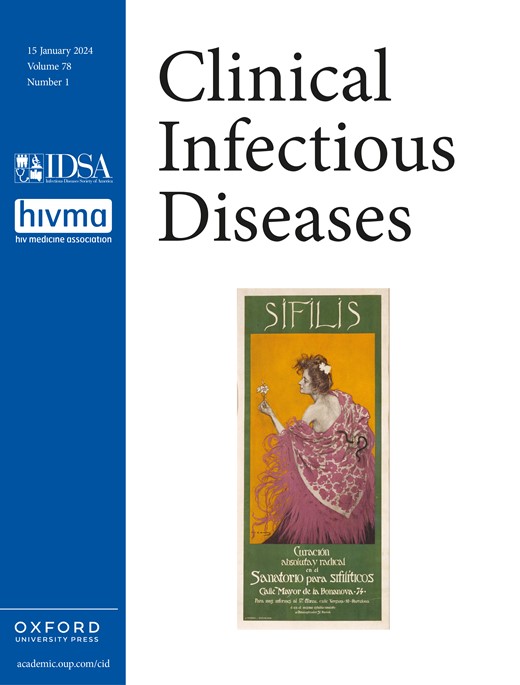Impact of a Collaboration-Focused Intervention to Prevent Healthcare-Associated Infections Before and During the Coronavirus Disease 2019 Pandemic.
IF 8.2
1区 医学
Q1 IMMUNOLOGY
引用次数: 0
Abstract
BACKGROUND Nursing home (NH) residents are susceptible to healthcare-associated infections (HAIs). Alignment among NHs, hospitals, and health departments is critical for effective implementation of infection prevention efforts. We tested a collaborative model that engaged hospitals and NHs to reduce infections among NH residents. METHODS We recruited 92 NHs and 15 hospitals over four 12-month cohorts (2018-2022). The intervention focused on HAI prevention; practices to reduce infection transmission; and effective communication among hospitals, NHs, and state health departments. NHs submitted data on urinary tract infection, catheter-associated urinary tract infection, Clostridioides difficile infection, methicillin-resistant Staphylococcus aureus infection, catheter use, and urine cultures. Changes in outcomes before and during the coronavirus disease 2019 (COVID-19) pandemic were assessed using multilevel negative binomial regression. RESULTS A total of 63 NHs (68%) partnered with 18 hospitals and submitted 2 or more months of outcome data. Forty NHs participated before COVID-19 (contributing to 1 364 492 resident-days, 56 258 device-days), and 23 NHs participated during COVID-19 (566 142 resident-days, 29 568 device-days). While reductions in the incidence of urine cultures (incidence rate ratio [IRR], 0.37; P < .001) and total composite infections (IRR, 0.68; P = .03) were observed before COVID-19, these reductions were not sustained during the pandemic. CONCLUSIONS Prior to COVID-19 pandemic, collaboration between NHs and referring regional hospitals with engagement from state health departments led to reductions in NH urine cultures and total infections. Although the pandemic significantly impacted our study, we demonstrate the importance of regional networks in promoting infection prevention in NHs.在2019冠状病毒病大流行之前和期间,以合作为重点的干预措施对预防医疗保健相关感染的影响
背景:疗养院(NH)的居民易患医疗保健相关感染(HAIs)。国家医疗服务体系、医院和卫生部门之间的协调一致对于有效实施感染预防工作至关重要。我们测试了一种合作模式,让医院和NHs参与进来,以减少NH居民的感染。方法:我们招募了92个NHs和15家医院,四个为期12个月的队列(2018-2022)。干预措施侧重于HAI预防;减少感染传播的做法;以及医院、NHs和州卫生部门之间的有效沟通。NHs提交了尿路感染、导尿管相关尿路感染、艰难梭菌感染、耐甲氧西林金黄色葡萄球菌感染、导尿管使用和尿液培养的数据。采用多水平负二项回归评估2019冠状病毒病(COVID-19)大流行之前和期间结局的变化。结果共有63家NHs(68%)与18家医院合作,并提交了2个月或更长时间的结局数据。40个NHs在COVID-19之前参与(贡献1 364 492个居民日,56 258个设备日),23个NHs在COVID-19期间参与(贡献566 142个居民日,29 568个设备日)。而尿培养发生率的降低(发病率比[IRR], 0.37;P < 0.001)和总复合感染(IRR, 0.68;P = .03),但在大流行期间,这些减少并未持续。结论在COVID-19大流行之前,NHs与转诊地区医院在州卫生部门的参与下开展合作,导致NH尿培养和总感染减少。虽然大流行严重影响了我们的研究,但我们证明了区域网络在促进NHs感染预防方面的重要性。
本文章由计算机程序翻译,如有差异,请以英文原文为准。
求助全文
约1分钟内获得全文
求助全文
来源期刊

Clinical Infectious Diseases
医学-传染病学
CiteScore
25.00
自引率
2.50%
发文量
900
审稿时长
3 months
期刊介绍:
Clinical Infectious Diseases (CID) is dedicated to publishing original research, reviews, guidelines, and perspectives with the potential to reshape clinical practice, providing clinicians with valuable insights for patient care. CID comprehensively addresses the clinical presentation, diagnosis, treatment, and prevention of a wide spectrum of infectious diseases. The journal places a high priority on the assessment of current and innovative treatments, microbiology, immunology, and policies, ensuring relevance to patient care in its commitment to advancing the field of infectious diseases.
 求助内容:
求助内容: 应助结果提醒方式:
应助结果提醒方式:


